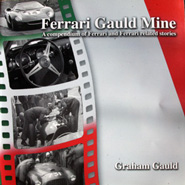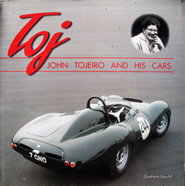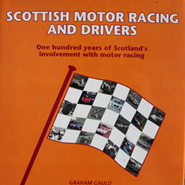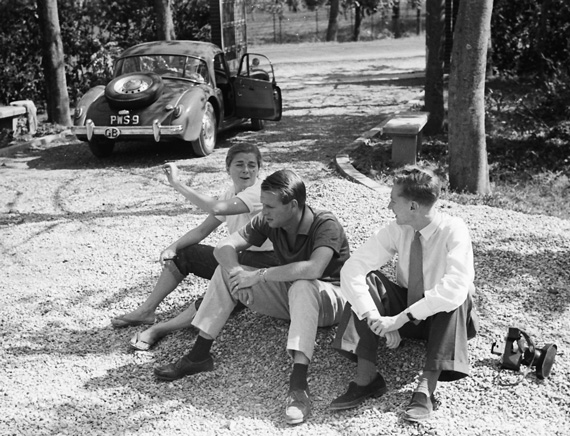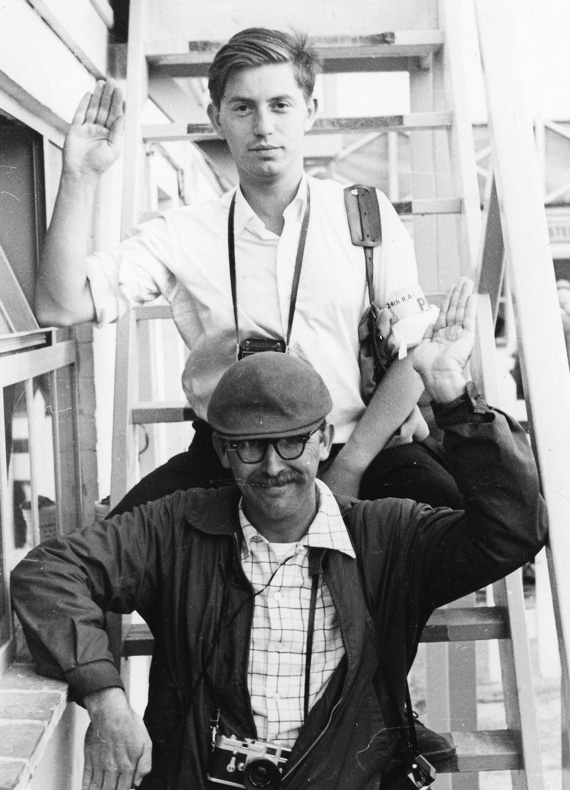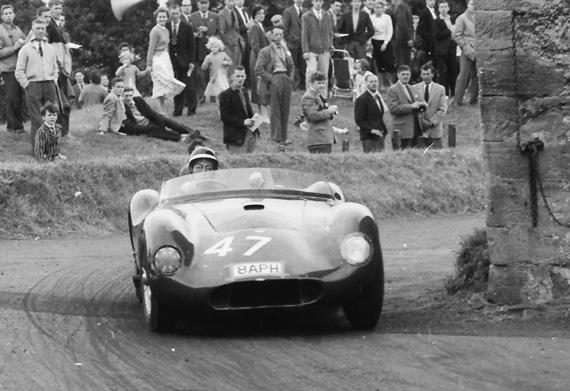Herein are three reviews of books written by Graham Gauld, all available now via his website, and now offered to VeloceToday readers for a very special price from http://www.smrh.co.uk/ by using the discount coupon code word Veloce (be sure to capitalize the V). Please note all shipping is free with the use of the special coupon. Any questions or issues can be sent to us at vack@cox.net.
Ferrari Gauld Mine
88 pages, softback, 10.50 by 10.50 inches
Havelock Publishing, Lesmahagow Scotland, 2007, copyright Graham Gauld
On sale now to VeloceToday readers for only $25 and free shipping!
As editors of the Ferrari Club of America’s publication, Prancing Horse, both Siebert and Allison (and Casey Clavin in between) were astute enough to realize that Gauld’s recollections, photos and interviews would add a lot to Ferrari history and therefore to the pages of Prancing Horse. Not only that, thanks to the editors, this 2007 anthology benefits from the corrections of hindsight, lining up more recent information about various chassis numbers histories with those of the often less-than-dependable memories of the original protagonists.
Gauld is the first to admit that he is no mechanical genius, but my guess is that he is being too modest and uses that as an unnecessary excuse for his accent on people rather than machines. Graham is above all a people person, affable, full of stories himself, and gets his subjects to open up while talking informally on a pit wall or on a barstool. His first line of the book, almost lost above a photo of himself, Peter and Louise Collins sitting in the Villa Rosa Gardens, reads “We tend to be precocious when we are young.” Fresh from the highlands of Scotland, totally unafraid, he jumped right into being a motoring journalist in Italy with an emphasis on the people that made things happen. To this day he remains as precocious as ever, still bringing us fresh insights from the participants themselves (mostly, thank goodness, via the pages of VeloceToday).
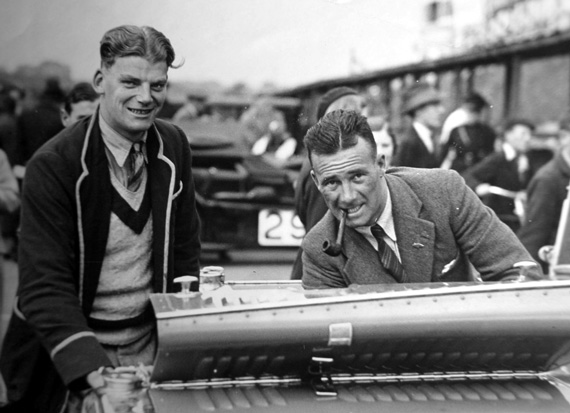
Peter Mitchell Thompson (left) was racing long before he became Lord Selsdon. But few knew this, including his son.
In the pages of Ferrari Gauld Mine, however, he gets Romolo Tavoni to talk frankly about Mrs. Ferrari and the palace revolt (which was really a wholesale firing); six months before the death of Luigi Villoresi, Graham manages a personal interview with Luigi, who was the terror of the wheelchair at his nursing home; he talks to Lord Selsdon’s son Malcolm, who remembers being in class when told that his father had won at Le Mans with Luigi Chinetti (“I didn’t even know my father was a racing driver!”); his talk with David Piper sheds some light on the fate of 365P1 s/ns 0822 and 0824; he writes a very touching remembrance of Henry Manney III, and of his truck-like 330GT, the first Ferrari Gauld ever drove. His interview with Giancarlo Baghetti is prophetic and details his years driving Ferraris and for Ferrari, long before becoming a photographer for the Italian edition of Playboy. (Such a life, but all too short!).
Gauld has a knack for telling one adventure many different ways…Ollon Villars, the Heinkel Bubble car…all while adding more perspective. He wrote a story for VeloceToday on his adventures at Ollon Villiers in 1958, but did not mention his meeting with Oliver Gendebien at the same event, which he relates for his column in the Prancing Horse. Gendebien had brought along what would be arguably the most successful 250 GT in history, and again won his class with s/n 0677. Graham’s memory…or personal notes…must be prodigious, for he recalls details that a lesser scribe would easily miss, and then is able to relate the details two generations later.
Ferrari Gauld Mine, then, is in all, 31 chapters, each an anecdote, each a classic, each one with a bit of information you probably didn’t know.
So, what of this book for your library? A must for Ferrari nuts, even those who may have all the Prancing Horses in their stable. Great stuff for race historians who concentrate on the fifties, and a nice read for anyone interested in Ferraris, racing, and above all, what makes people tick. In some ways, I liked it better than Modena Memories, for it is full of bite sized nuggets. Downside; softback only, good paper but the excellent period B&Ws lack gloss and appear flat; a printing fault that may be on just my copy.
_________________
Toj: John Tojeiro and his cars
95 pages, softback, 10.50 by 10.50 inches
Havelock Publishing, Lesmahagow Scotland, 2005, copyright Graham Gauld
On sale now to VeloceToday readers for only $25 and free shipping!
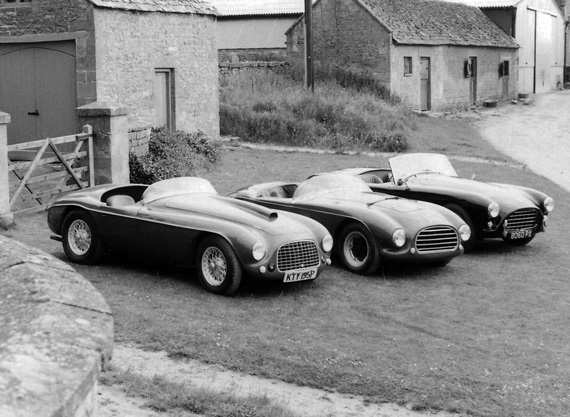
John Baker lined up an original Ferrari 166 with the prototype Tojeiro A.C. Ace, and the production version.
Graham Gauld and I once crossed paths unknowingly at the intersection of America and Tojeiro. I became familiar with John Tojeiro back in the 1980s while doing an article for Sports Cars Illustrated about the Hopf Tojeiro, one of four Climax-powered race cars built by Tojeiro in the late 1950s then being harbored in Baltimore, Maryland. But though I knew of Graham Gauld, I had no idea that he was a good friend of the elusive and shy Tojeiro; certainly there was very little information about him, but we managed to cobble up an article based on the recollections of Russ Hopf.
In an age before emails, cellphones, and no easy or inexpensive way to communicate across the pond, we missed each other’s efforts. Small already, the world of car enthusiasts became much, much smaller with the advent of the Internet. But years later – in 2013 – Graham sent me his book about the builder and I was pleased and impressed that he had incorporated the Hopf Tojeiro material into his book, complete with credits. It is gratifying to be able to contribute to such a fine effort.
Aside from Doug Nye in his book “Powered by Jaguar”, Graham was about the only one to tackle this Portuguese- born idiosyncratic race car builder. And though he had known “Toj” for 45 years, he didn’t’ embark upon a book about Tojeiro until only a few years before the designer’s death in 2004. John was a homegrown near-genius with a gift for race car construction and design; but he couldn’t keep records, notes, bills, nor effectively run a business. Therefore it was a bit of a challenge to piece together all the Tojeiros built (and apparently two chassis simply just plain disappeared over the years) as well as list the changes, differences and engines. And of engines, Tojeiro used not only Jaguars, but Chevies, Fords, MGs, JAPs, Coventry Climax, and more, in a career that lasted from 1950 to the late 1960s.
But alas, Tojeiro cars were never really successful on or off the track. Yet everyone knew about the cars and was familiar with them to some degree. His main claim to fame may have been the Cobra. Right off the mark working from his tiny garage after WWII, Tojeiro had created several successful 1100 racers with Cooper-like frames and Fiat 500-based independent front suspension and often with de Dion rear suspension. This got him noticed, and soon he was involved in the intricate affairs of the several Ferrari barchetta-like cars with Cooper and Tojeiro chassis, actually building the famed LOY 500 with a Bristol engine for Cliff Davis. This in turn led to an offer from A.C. Cars to produce a sports car based on his chassis, a Bristol engine, and with another Ferrari barchetta-like body on a chassis originally powered by a Lea Francis engine. By 1954 this had been developed by A.C. into the A.C. Ace, which was later fitted with the Ford 260 V8 to become the A.C. Cobra. A milestone car, then, but Tojeiro, never the businessman, only received 500 £ for his efforts.
Tojeiro though, was in his element and next became involved in the creation of three Tojeiro Jaguars for David Murray and Ecurie Ecosse, via his now friend and backer, John Ogier. This continued, with a limited amount of success, until the early 1960s. Tojeiro was running out of money and the game was becoming ever so much more complex and corporate. He decided to opt out of racing, establishing a small plastics company that kept him going until retirement in the 1980s.
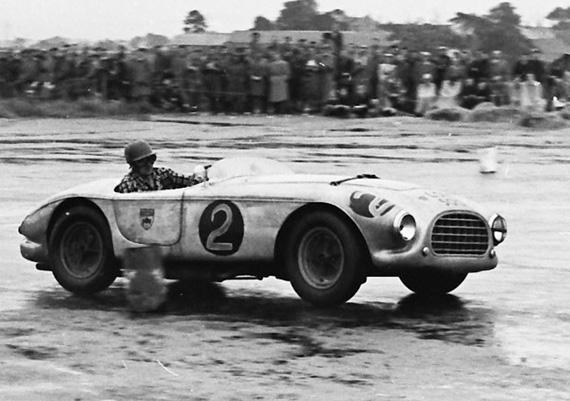
Cliff Davis with his favorite checkered shirt behind the wheel of his Cooper MG at the Scottish circuit Charterhall. The Cooper MG was the car that started it all, begetting the Tojeiro A.C. and eventually the Cobra.
In his very merry people way, Gauld takes us through the pages of Tojeiro history, bringing to life characters like Cliff Davis, Peter Hughes, David Murray, John Ogier and the many enthusiasts who surrounded and supported John Tojeiro. We learned a lot and enjoyed doing it. Gauld also lists the cars considered true Tojeiros and a bit of history of each. He also repeatedly states the difficulties in verification and the problems of many fakes and replicas that now abound. Many Tojeiro cars didn’t even have serial numbers.
He was the last of a breed. Guys like Tojeiro, de Tomaso, and others who could create reasonably successful race cars without a lot of money (in Tojeiro’s case, never enough), without corporate backing, and most of all, without the aid of computers. It was a wonderful time to be an engineer involved with racing and surely will never come again.
_________________
Scottish Motoring Racing and Drivers
196 pages, hardback, 10.25 by 10.25 inches, color and black and white photos.
Havelock Publishing, Lesmahagow Scotland, 2004, copyright Graham Gauld
On sale now to VeloceToday readers for only $50 and free shipping!
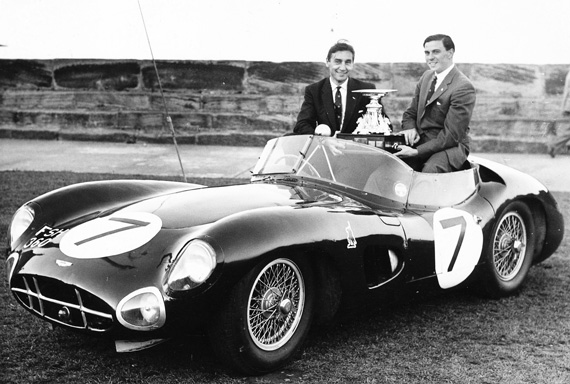
in 1960 the Scottish team Border Reivers entered this Aston Martin for Clark and Salvadori. They finished third, one of many successful outings at Le Mans for Scottish racing teams.
This is an unusual book that from the title appears to be rather arcane. Ok, Jimmy Clark, Jackie Stewart, Paul di Resta, David Coulthard, Dario and Marino Franchitti are more or less familiar Scottish heroes, but wait there’s more; Margeret Allan, Bill Binnie, Archie Scott Brown, Rob Walker, Ninian Sanderson, Andrew Cowan, Ron Flockhart, Innes Ireland, Alexander Hesketh, Lord Laidlaw, Patrick Lindsay, Allan McNish, TASO Mathieson, Lord Selsdon, Tom Walkinshaw and many more lesser stars are brought to light in this fascinating book about Scottish racing history. It includes Scottish racing venues, Scottish cars and above all, the drivers and major players who hailed from Scotland. And as usual, Graham Gauld writes as if he knew them all personally, and even more impressive, probably did! Sir Jackie Stewart does the Forward with some very complimentary words on Mr. Gauld.
Gauld is no doubt the only person who could put together such a history and do so with great vigor, enthusiasm and wall to wall coverage; he begins at the turn of the 20th century (noting the loss of an influential Scot by the name of Alexander Winton to the Americas) and brings it right on through to 2004. While that sounds like a rather large byte, admittedly there was very little activity after the initial flourish of the Scottish Automobile Club in 1899 to after World War II. Hence Graham covers a lot of ground with 196 pages and thirteen chapters, but most are devoted to post-WWII activities. Note that he does not list the events in detail nor does he provide any list of entrants, classes or placings; this is not a Terry O’Neil or Willem Oosthoek book, it is a Graham Gauld book.
Very early on, the British government had banned all racing on public roads, racing was a tough go for Scotland—and the cost of building special facilities and special permissions needed for racing remained a problem ever since. Gauld devotes a special chapter to the “Phantom Circuits” of Scotland, those planned over the years but failed to get off the ground for one reason or another. There was no space or money for a facility like Brooklands near London, so enthusiasts and motoring clubs struggled for years to provide legal and safe venues for racing and hillclimbs.
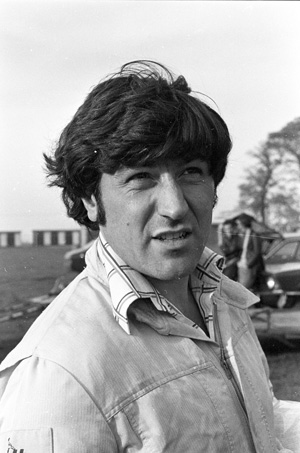
The father of Marino and Dario Franchitti, George, was active in Scottish racing circles during the 1970s.
The largest single chapter is entitled “Scottish Racing Drivers” and of course that’s where Gauld excels. He notes that the sections on Jim Clark and Sir Jackie Stewart are somewhat abbreviated because there are already plenty of books on the subjects; he wanted to allow room to expand on drivers like Ron Flockhart (providing previously unpublished details of his fatal plane crash), Archie Scott Brown, Innes Ireland and others who never got much press.

Later head of Ecurie Ecosse, David Murray campaigned Maseratis in the early 1950s. Here in his 4CL which was followed by a 4CTL/48.
While French cars were virtually nonexistent in Scotland, Gauld notes the odd Italian cars, along with drivers as well as final dispositions as possible. Ecurie Ecosse boss David Murray ran two Grand Prix Maseratis before establishing his famous team, Farina raced the Thinwall Special at Charterhall, Horace Gould and Stirling Moss brought their 250Fs, Bira his 4CTL, but the book in nonetheless rich in post war racing history and anecdotes.
